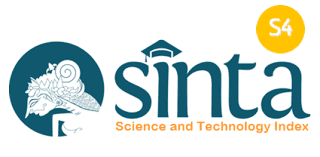DETERMINATION OF SUN PROTECTION FACTOR (SPF) VALUE IN LIME (CITRUS AURANTIFOLIA) PEEL EXTRACT USING UV-VIS SPECTROPHOTOMETRY METHOD
Abstract
Lime (Citrus aurantifolia) is a plant that contains phenolic compounds, such as phenols, flavonoids, and tannins. With this content, lime peel extract has the potential as a sunscreen and has antioxidant activity. Sunscreen compounds refer to ones that can protect the skin from the effect of ultraviolet radiation. At first, the peel was extracted by maceration method using three solvents with different polarity (n-hexane, ethyl acetate, and 70% ethanol). The preliminary test found that the ethyl acetate and ethanol 70% extracts positively contained phenol, tannin, and flavonoid compounds, which were marked by a color change in the sample and continued to test the sunscreen activity. Further, the sunscreen activity test was determined based on the determination of the Sun Protection Factor (SPF) value that was done at 290-320 nm (wavelength) with a 5 nm interval. The results showed that the sunscreen activity of the peel extract is very good at a concentration of 200 ppm for ethyl acetate extract with a value of 28.8; meanwhile, ethanol extracts 70% and ethyl acetate extracts of 400 and 600 ppm concentrations with an average SPF value of 24, 42.5, 42.2 and 81.8, respectively, are included in ultra protection because they have an SPF value of >15.
Keywords
Full Text:
PDFReferences
Ambrus, A., & Hamilton, D. J. (2017). Food safety assessment of pesticide residues. World Scientific.
Artini, P. D., Astuti, K. W., & Warditiani, N. K. (2013). Uji fitokimia ekstrak etil asetat rimpang bangle (Zingiber purpureum Roxb.). Jurnal Farmasi Udayana.
Ayoola, G. A., Coker, H. A., Adesegun, S. A., Adepoju-Bello, A. A., Obaweya, K., Ezennia, E. C., & Atangbayila, T. O. (2008). Phytochemical screening and antioxidant activities of some selected medicinal plants used for malaria therapy in Southwestern Nigeria. Tropical Journal of Pharmaceutical Research, 7(3), 1019-1024.
Barile, E., Bonanomi, G., Antignani, V., Zolfaghari, B., Sajjadi, E., Scala, F., & Lanzotti, V. (2007). Phytochemical screening and antimicrobial assessment of Abutilon mauritianum, bacopa monifera and Datura stramonium. Phytochemistry, 68, 596-603.
Bonda, C. (2009). Sunscreen photostability 101. Happi, October.
Eram, S., Ahmad, M., & Arshad, S. (2013). Experimental evaluation of Echinops echinatus as an effective hepatoprotective. Scientific Research and Essays, 8(39), 1919-1923.
Gandjar, I. G., & Rohman, A. (2012). Analisis obat secara spektrofotometri dan kromatografi. Yogyakarta: Pustaka Pelajar, 316, 368-381.
Harborne, J. B. (1987). Metode fitokimia: Penuntun cara modern menganalisis tumbuhan. Bandung: Penerbit ITB, 78.
Isfardiyana, S. H. (2014). PENTINGNYA MELINDUNGI KULIT DARI SINAR ULTRAVIOLET DANCARA MELINDUNGIKULIT DENGAN SUNBLOCK BUATAN SENDIRI. Asian Journal of Innovation and Entrepreneurship, 3(2), 126-133.
Kristanti, A. N., Aminah, N. S., Tanjung, M., & Kurniadi, B. (2008). Buku ajar fitokimia. Surabaya (ID): Airlangga University Pr, 3-161.
Lavi, N. (2013). Tabir Surya Bagi Pelaku Wisata. Universitas Udayana: Denpasar.
Marliani, L., Velayanti, R., & Roni, A. (2015). Aktivitas antioksidan dan tabir surya pada ekstrak kulit buah pepaya (Carica papaya L.). Prosiding SNaPP: Kesehatan (Kedokteran, Kebidanan, Keperawatan, Farmasi, Psikologi), 1(1), 319-324.
Mokodompit, A. N., Edy, H. J., & Wiyono, W. (2013). Penentuan nilai sun protective factor (SPF) secara in vitro krim tabir surya ekstrak etanol kulit alpukat. Pharmacon, 2(3).
More, B. H., Sakharwade, S. N., Tembhurne, S. V., & Sakarkar, D. M. (2013). Evaluation of Sunscreen activity of Cream containing Leaves Extract of Butea monosperma for Topical application. International Journal of Research in Cosmetic Science, 3(1), 1-6.
Prasiddha, I. J., Rosalina, A. L., Teti, E., & Jaya, M. M. (2016). Potensi senyawa bioaktif rambut jagung (Zea mays L.) untuk tabir surya alami: Kajian pustaka. Jurnal Pangan Dan Agroindustri, 4(1), 40-45.
RI, D. P. D. (1986). Sediaan galenik. Departemen Kesehatan RI, Jakarta.
Robinson, T. (1995). Kandungan organik tumbuhan tinggi.
Sangi, M. S., Momuat, L. I., & Kumaunang, M. (2012). Uji toksisitas dan skrining fitokimia tepung gabah pelepah aren (Arenga pinnata). Jurnal Ilmiah Sains, 12(2), 127-134.
Sestili, P., Guidarelli, A., Dachà , M., & Cantoni, O. (1998). Quercetin prevents DNA single strand breakage and cytotoxicity caused by tert-butylhydroperoxide: Free radical scavenging versus iron chelating mechanism. Free Radical Biology and Medicine, 25(2), 196-200.
Shirley, B. W. (1996). Flavonoid biosynthesis:"˜new'functions for an "˜old'pathway. Trends in Plant Science, 1(11), 377-382.
Sylvia, T. (n.d.). P., 2009, Mikrobiologi Farmasi, 173-180. Erlangga, Jakarta.TAUPIK, M. (2015). ISOLASI DAN IDENTIFIKASI SENYAWA TOKSIK DARI TUMBUHAN Spigelia anthelmia Linn KOLEKSI DARI KAWASAN PANTAI SELATAN, KABUPATEN BANTUL, DAERAH ISTIMEWA YOGYAKARTA [PhD Thesis]. [Yogyakarta]: Universitas Gadjah Mada.
Taupik, M., Djuwarno, E. N., Mustapa, M. A., & Sahumena, M. H. (2020). IDENTIFIKASI DAN STUDI POLA FRAGMENTASI JAMU TERKONFIRMASI FENILBUTAZON MENGGUNAKAN LIQUID CHROMATOGRAPHY MASS SPECTROSCOPY (LCMS). SCIENTIA: Jurnal Farmasi Dan Kesehatan, 10(2), 243-
DOI: https://doi.org/10.35971/jjhsr.v3i2.10319
Refbacks

This work is licensed under a Creative Commons Attribution-ShareAlike 4.0 International License.
Jambura Journal of Health Sciences and Research is licensed under a Creative Commons Attribution-ShareAlike 4.0 International License
</p



_.png)




_edit.png)




